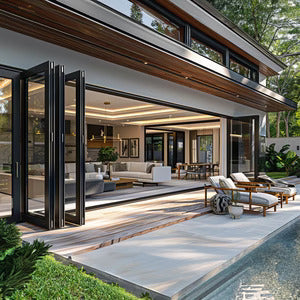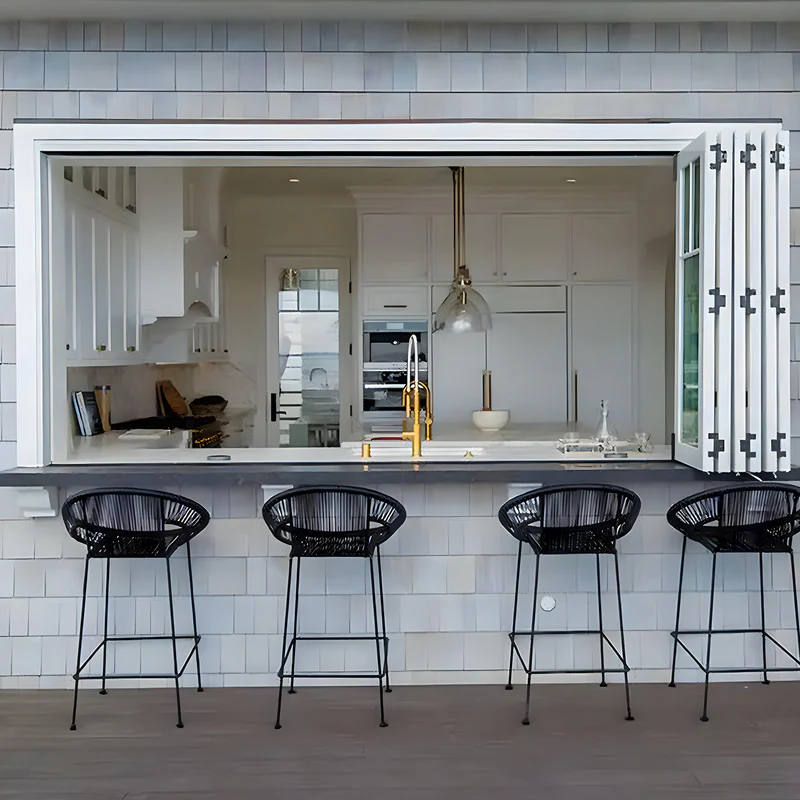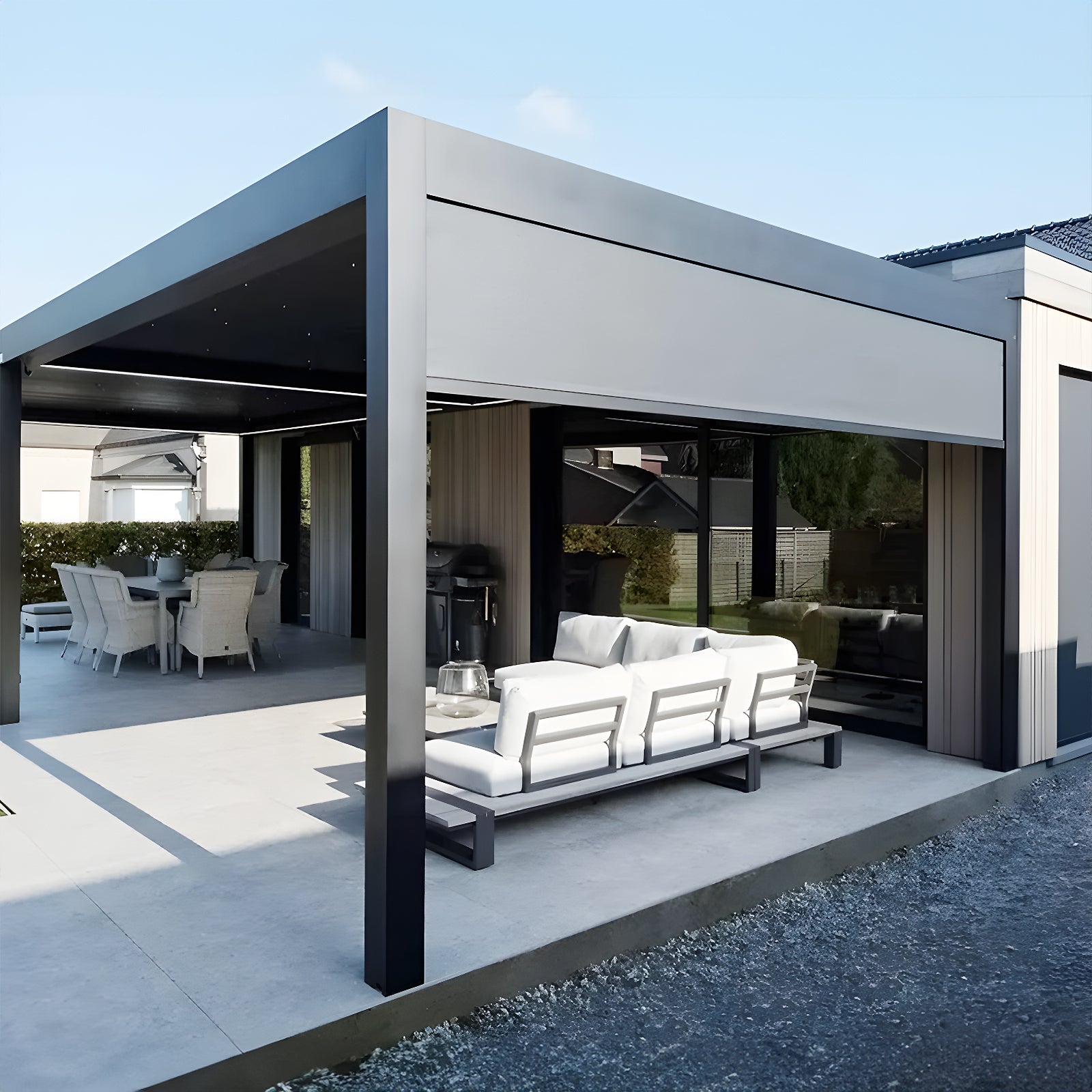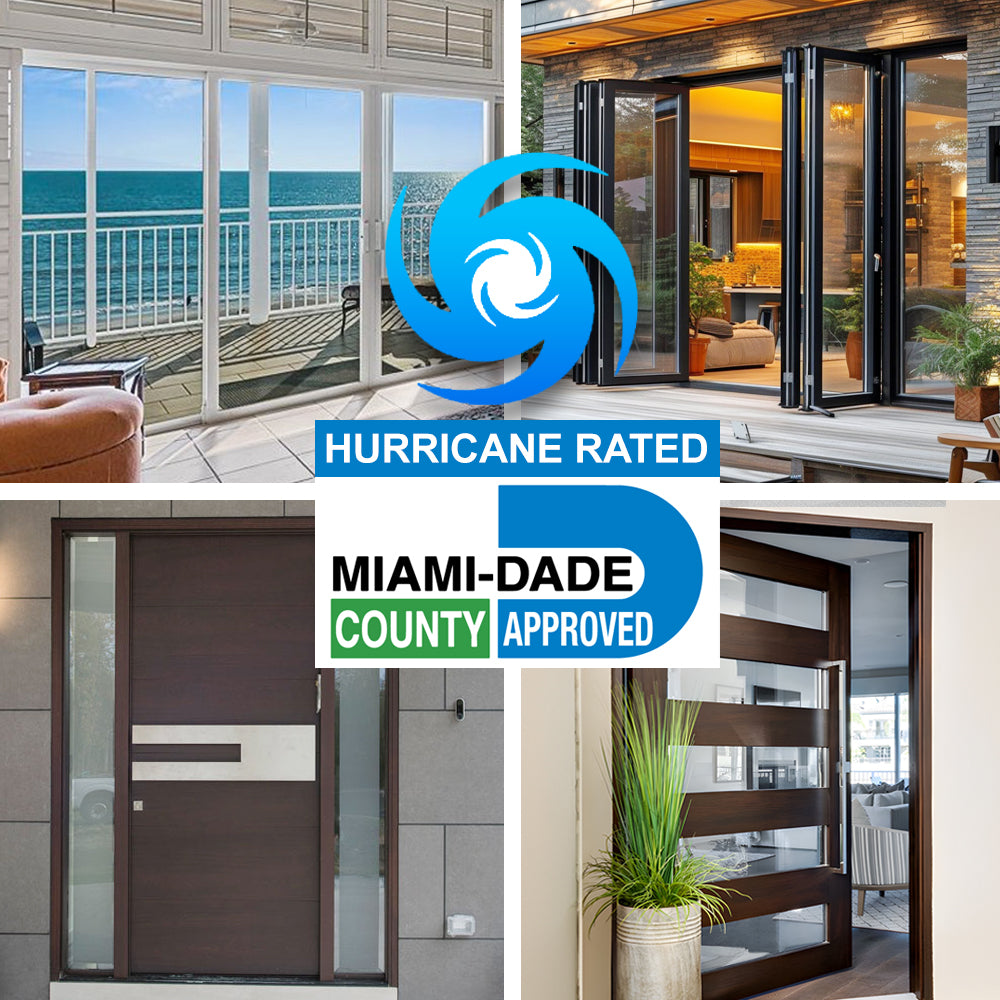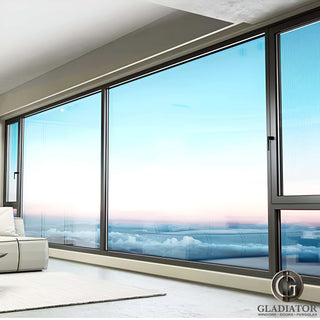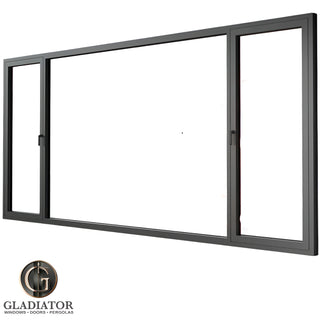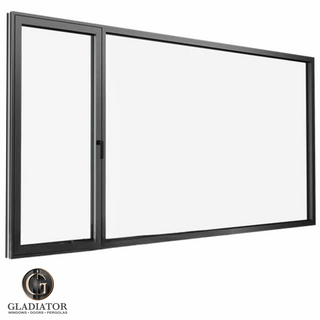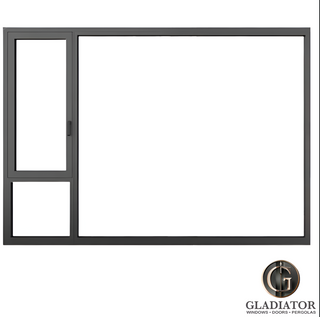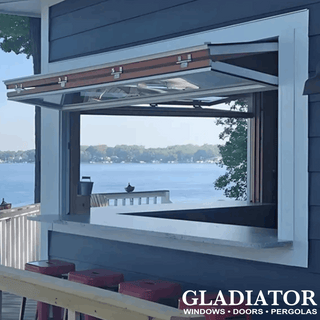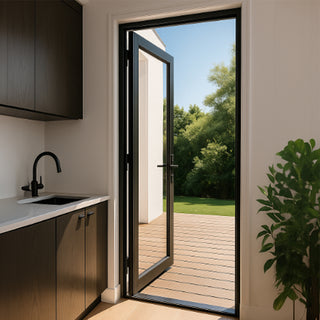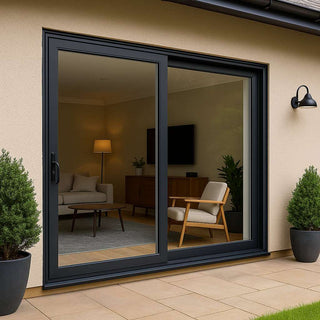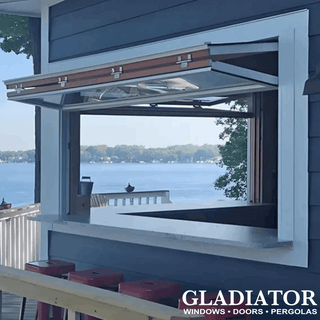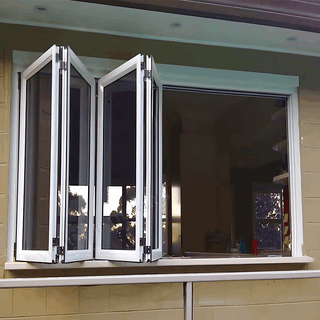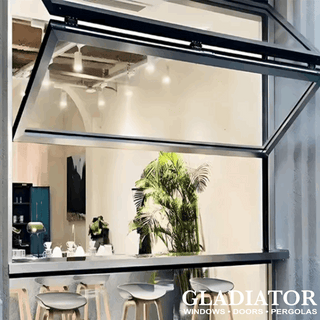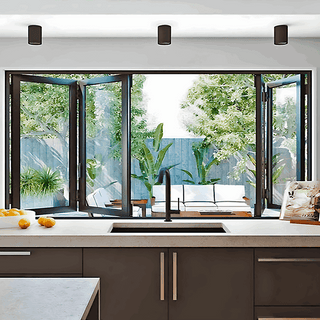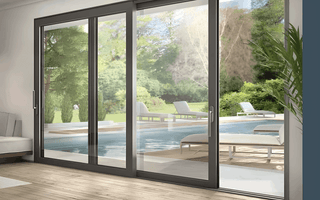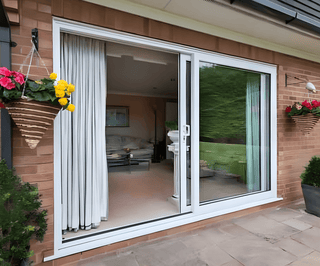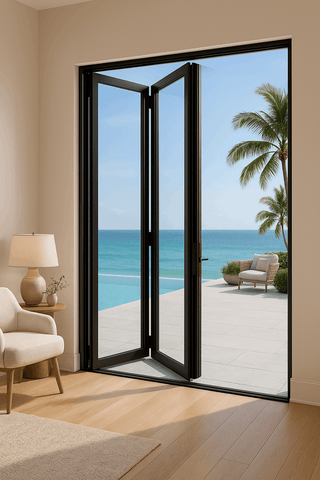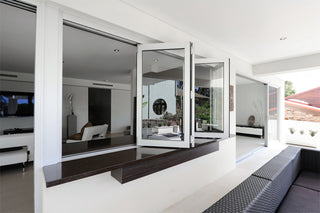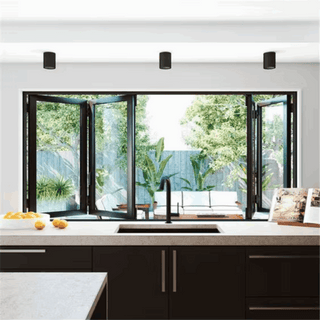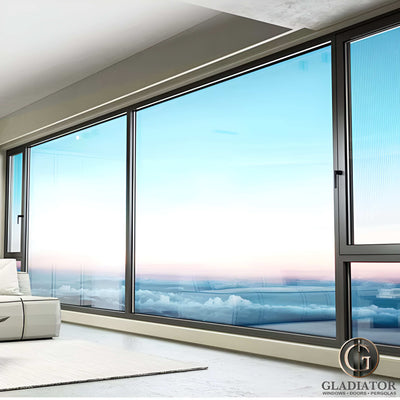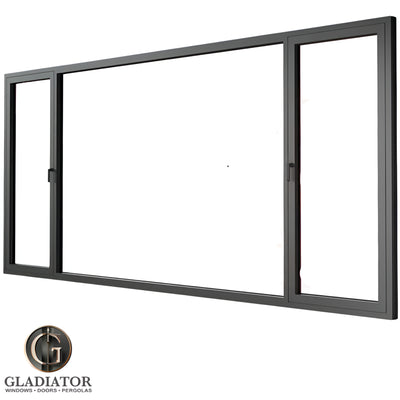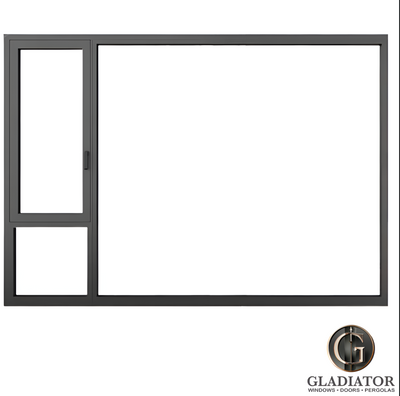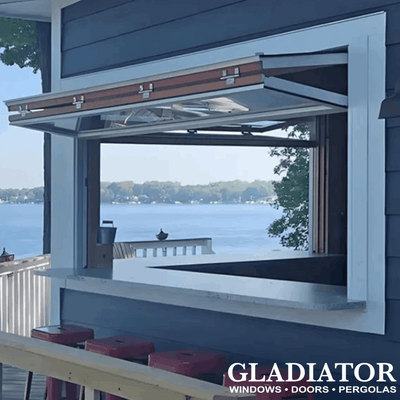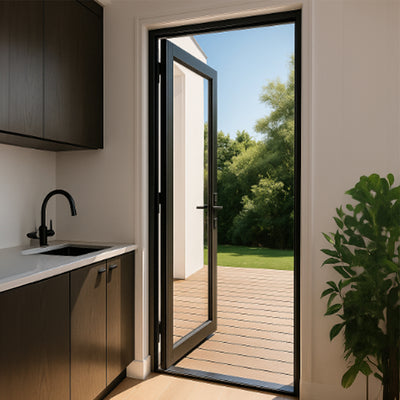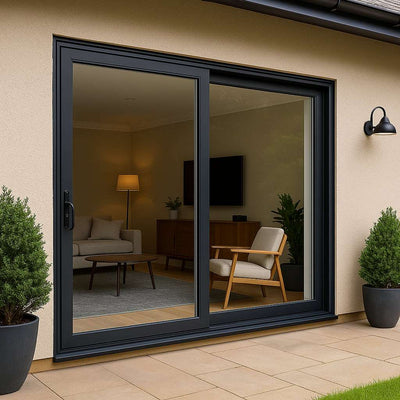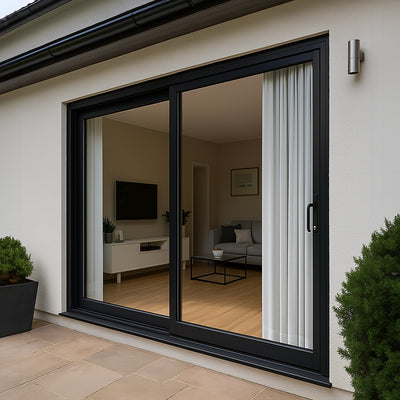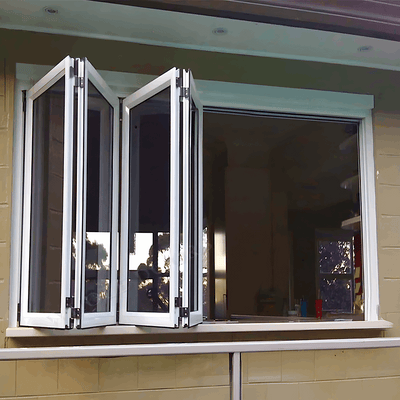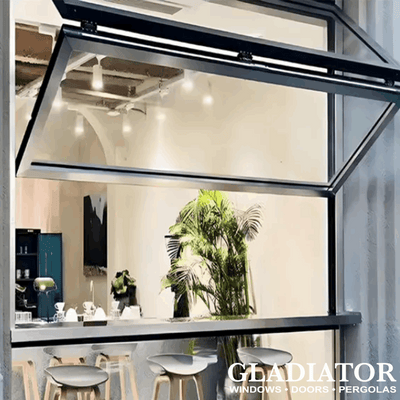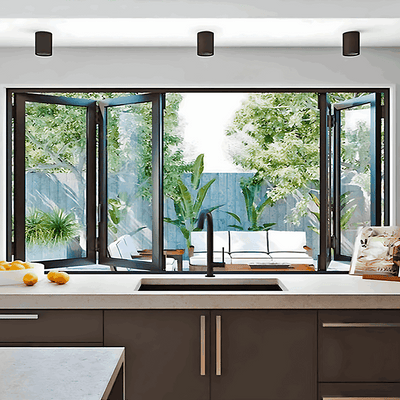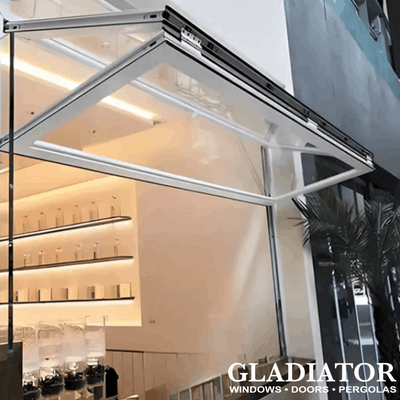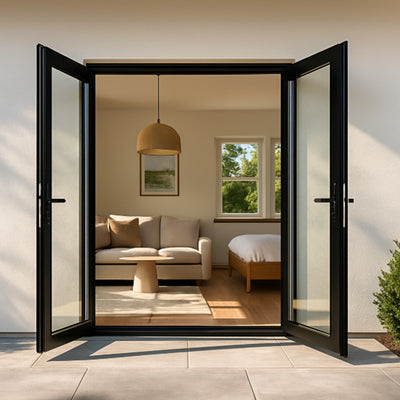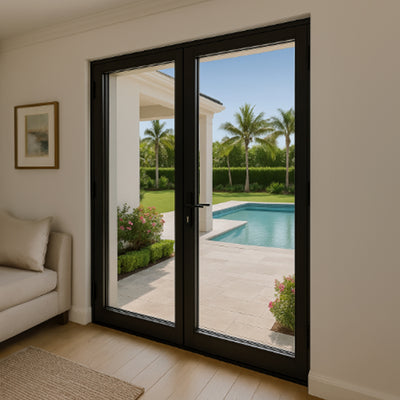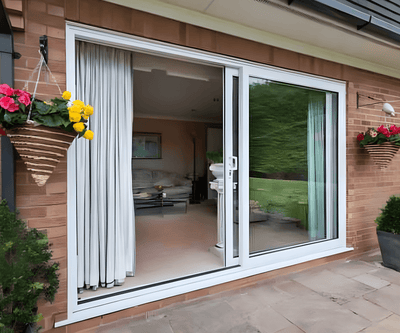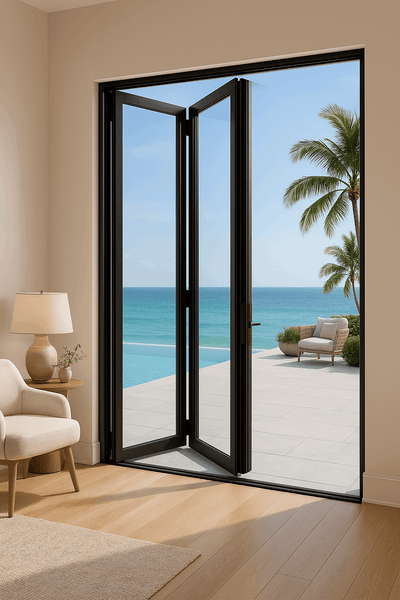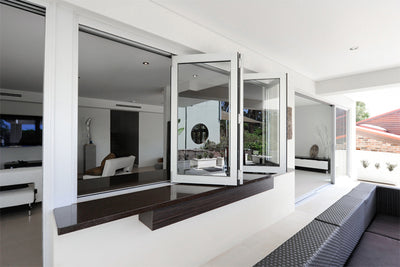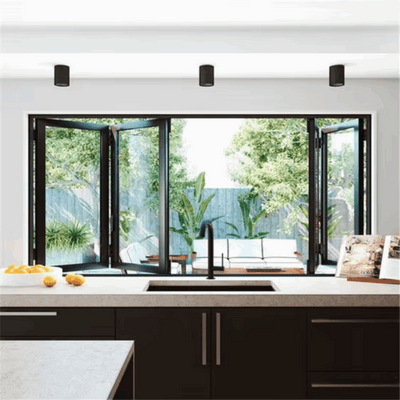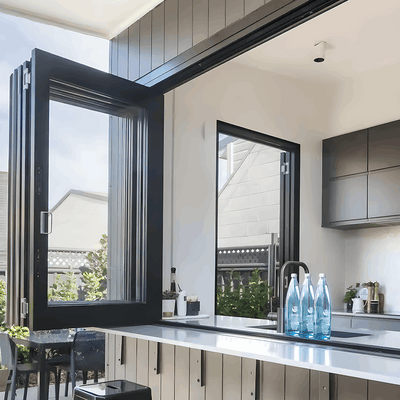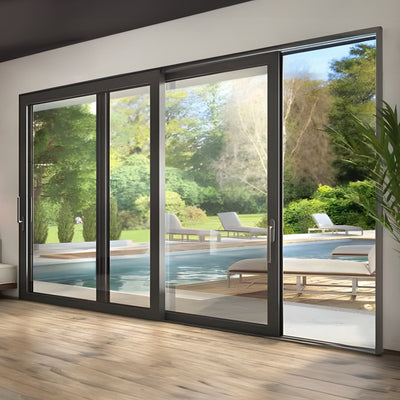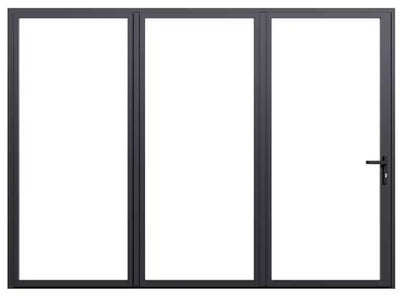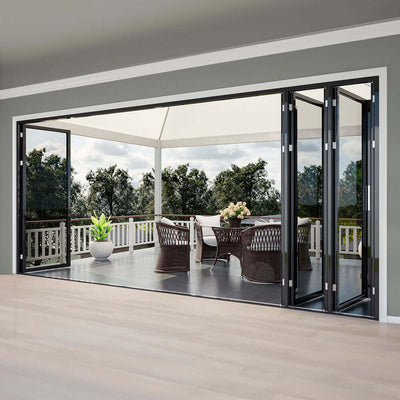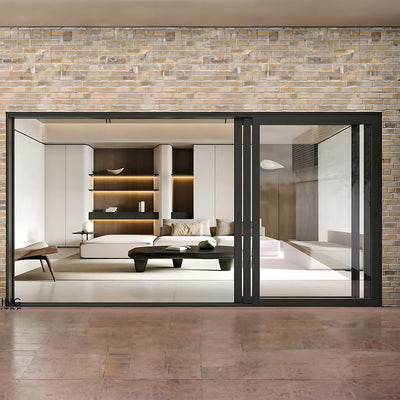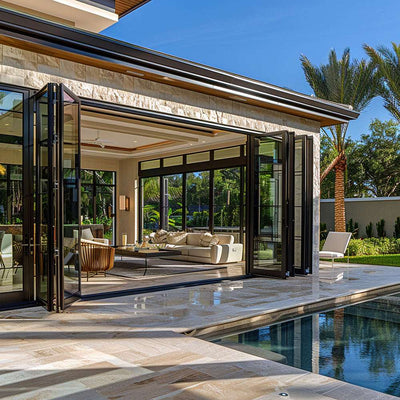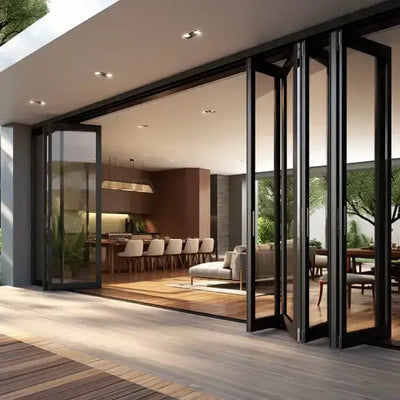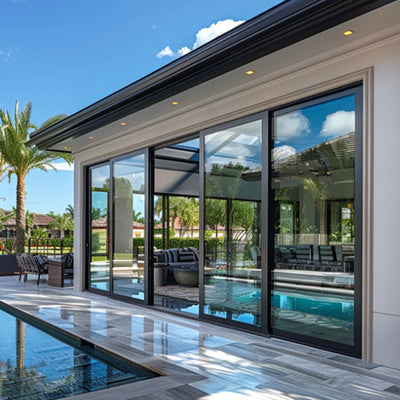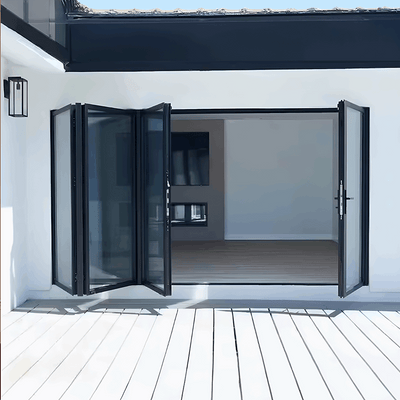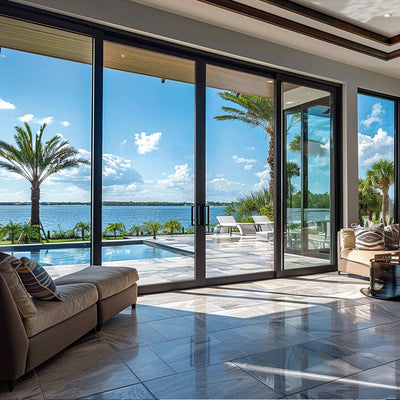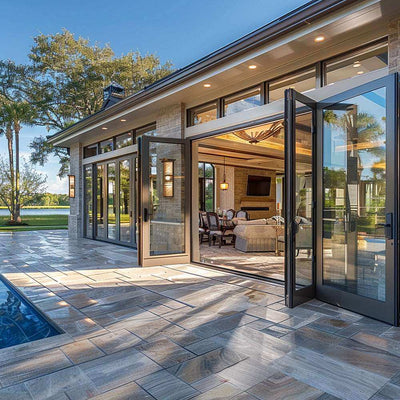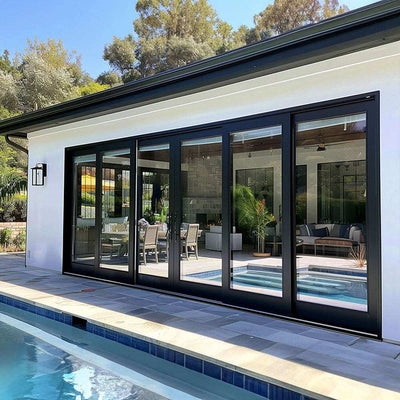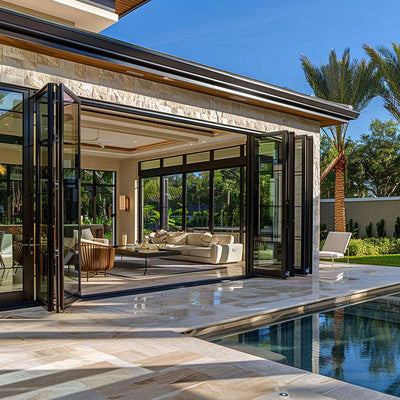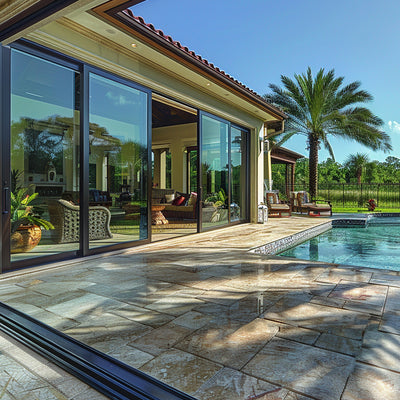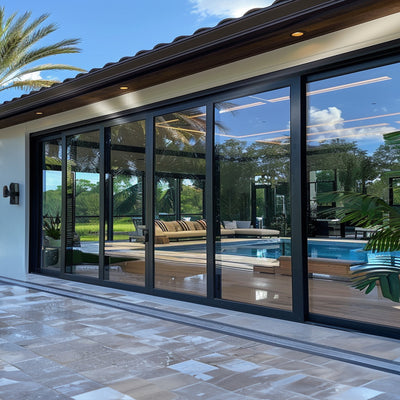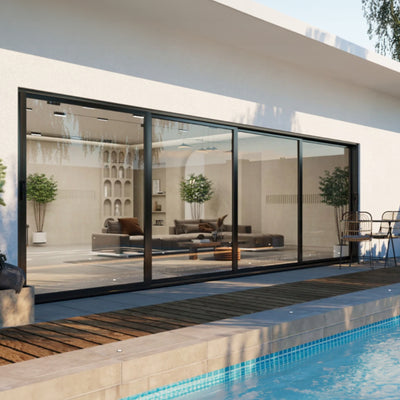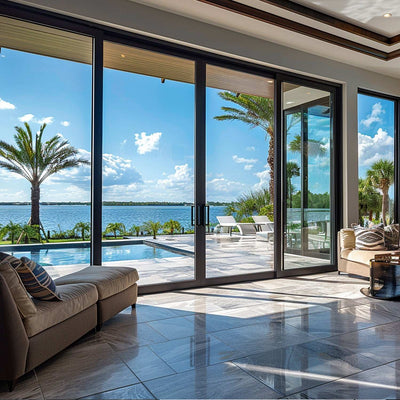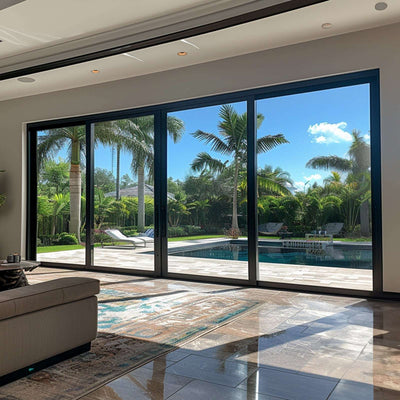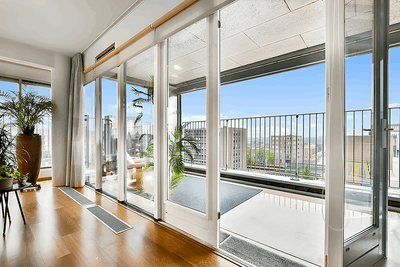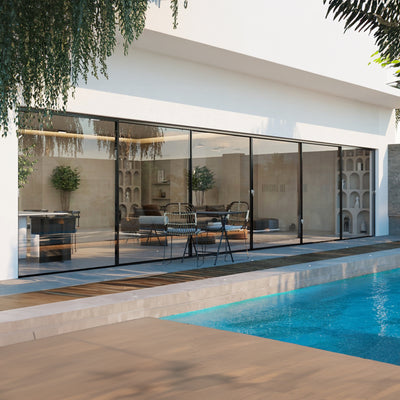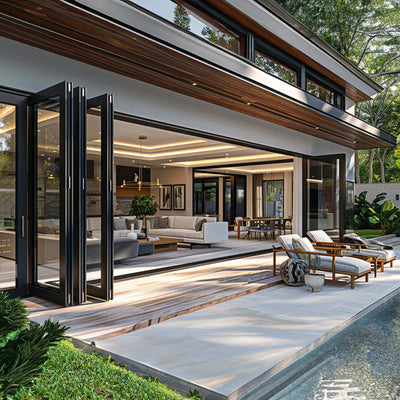Elevate Your Home's Entrance
Choosing the right door for your home can significantly impact its curb appeal, security, and energy efficiency. This guide simplifies the selection process by showcasing eight different types of doors for homes, including interior and exterior options. Learn about the advantages and disadvantages of Gladiator Window and Doors, solid wood doors, fiberglass doors, steel doors, hollow-core interior doors, solid-core interior doors, French doors, and sliding/pocket doors. Find the ideal door to enhance your home's aesthetic and functionality.
1. Gladiator Window and Doors
When considering different types of doors for homes, Gladiator Window and Doors stands out as a premium option for those seeking custom solutions and large-scale designs. This American manufacturer specializes in thermally rated, USA-approved windows, doors, and pergolas, catering to both residential and commercial projects. Their offerings extend beyond standard sizes, with impressive capabilities for massive sliding doors up to 30 feet wide and a variety of styles including pivot, bi-fold, folding, and panoramic doors. This makes them an excellent choice for homeowners looking to create dramatic entrances, expand indoor-outdoor living spaces, or maximize natural light. Beyond doors, their fully loaded pergolas, equipped with features like electric louvers, motorized screens, and glass enclosures, can transform outdoor areas into versatile, all-season retreats.
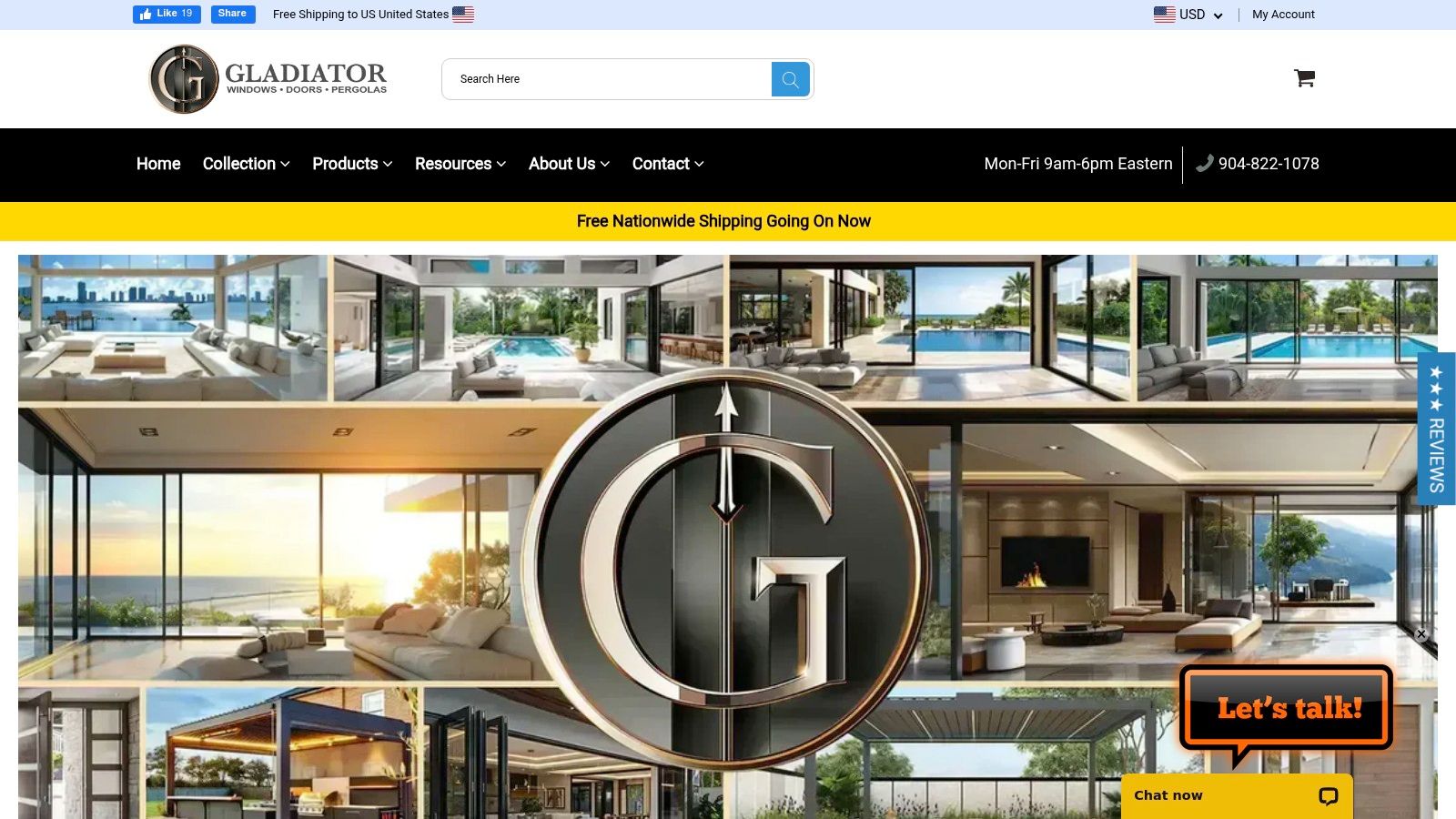
Gladiator emphasizes both aesthetics and functionality. Their custom-made approach allows homeowners, contractors, and developers to tailor door and pergola designs to specific architectural needs and stylistic preferences. This is particularly valuable for new construction, renovations, and remodels where integrating unique and oversized door systems can significantly elevate the overall design. The company’s commitment to thermal efficiency ensures energy savings and improved comfort, a crucial factor for homeowners in various climates. While information on pricing isn’t directly available on the website, their Best Offer Guarantee promises the lowest prices in the USA without compromising quality, complemented by free nationwide shipping. Learn more about Gladiator Window and Doors for details on their extensive product range.
Pros:
- Custom-made, thermally rated, and USA-approved products ensure superior performance and durability.
- Industry-leading low prices with a Best Offer Guarantee and free nationwide shipping.
- Extensive product range, including extra-large sliding, pivot, bi-fold, panoramic doors, and fully featured pergolas.
- Strong customer satisfaction backed by over 450 positive reviews praising quality, design, and service.
- Comprehensive warranty coverage and professional installation support contribute to a seamless buying experience.
Cons:
- Limited operating hours (Mon-Fri, 9 am-6 pm Eastern) might affect immediate customer support availability for some time zones.
- Pricing details require direct inquiry for quotes, which might be less convenient for some customers.
Gladiator Window and Doors earns its spot on this list due to its focus on custom craftsmanship, large-scale door solutions, and commitment to providing high-quality products at competitive prices. Their comprehensive approach, covering design, manufacturing, and installation, simplifies the process for those seeking premium different types of doors for homes and outdoor living enhancements. They cater to a broad audience including homeowners, condo owners, contractors, builders, developers, and commercial property owners, especially those embarking on new construction, renovations, or remodeling projects.
2. Solid Wood Doors
When considering different types of doors for homes, solid wood doors stand out as a timeless classic. They represent traditional craftsmanship and offer a level of quality and beauty often unmatched by other door materials. Constructed from hardwoods like oak, maple, cherry, or mahogany, these doors bring the warmth and character of natural wood into your home. Each piece possesses unique grain patterns, making every door a distinct statement. Solid wood doors are versatile and can be stained, painted, or left natural to complement various design aesthetics. They are frequently chosen for entry doors, where they create a grand first impression, as well as for high-end interior applications where their beauty and durability are highly valued. Beyond their aesthetic appeal, they also offer excellent insulation and sound dampening, contributing to a comfortable and quiet home environment.
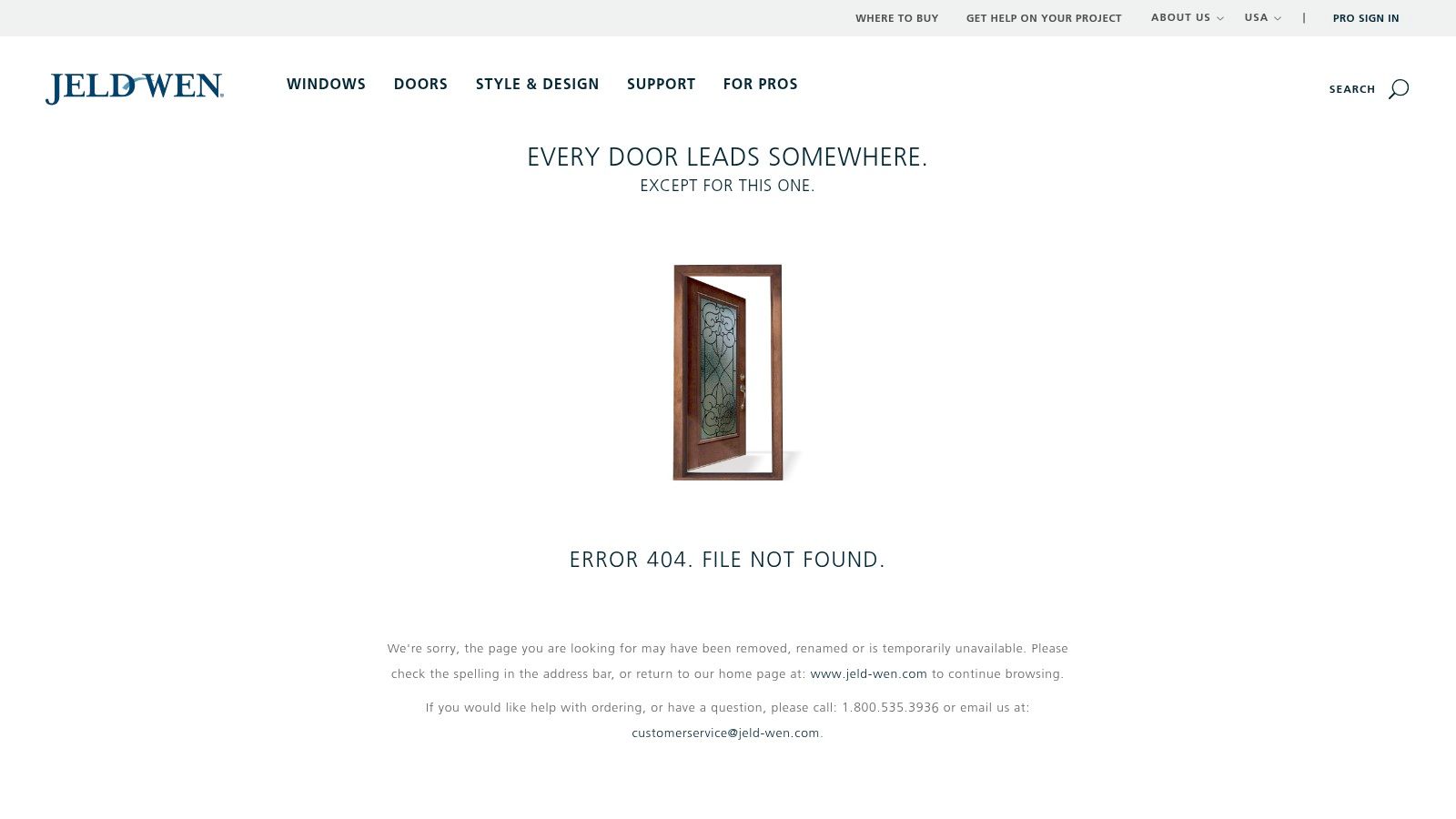
Solid wood doors are typically 1¾ inches thick for exterior applications, providing robust security and weather resistance. This thickness also contributes to their superior sound insulation capabilities, making them an excellent choice for bedrooms, home offices, or any space where noise reduction is desired. For interior applications, thinner options are often available. The ability to customize these doors further distinguishes them from other types of doors for homes. They can be custom carved with intricate designs or crafted to specific dimensions, allowing homeowners and builders to achieve a truly personalized look. The wide variety of wood species and finishes available ensures a perfect match for any architectural style, from traditional to contemporary.
While solid wood doors offer numerous advantages, it's essential to consider the practical aspects. They are typically more expensive than hollow core or engineered wood alternatives. Pricing varies depending on the wood species, design complexity, and hardware choices. Additionally, solid wood is susceptible to warping and shrinking with fluctuations in temperature and humidity. This requires regular maintenance, including sealing and refinishing, to preserve their beauty and functionality. Homeowners in climates with extreme temperature swings should consider these factors carefully. Finally, solid wood doors are heavier than hollow core alternatives, requiring robust framing and potentially more substantial hardware.
Features:
- Made from natural hardwoods (oak, maple, cherry, mahogany)
- Can be custom carved or designed
- Natural insulation properties
- Available in various wood species and finishes
- Typically 1¾ inches thick for exterior applications
Pros:
- Excellent durability when properly maintained
- High aesthetic value and timeless appeal
- Good sound insulation
- Can be refinished multiple times
Cons:
- Expensive compared to other door types
- Susceptible to warping and shrinking with temperature and humidity changes
- Requires regular maintenance (sealing/finishing)
- Heavier than hollow core alternatives
Website: JELD-WEN Wood Doors
Solid wood doors deserve their place on this list of different types of doors for homes because of their unparalleled combination of beauty, durability, and performance. They offer a premium option for homeowners seeking a classic and enduring aesthetic, enhanced privacy, and superior sound control. While the investment may be higher, the long-term value and timeless appeal of a solid wood door make it a worthwhile consideration.
3. Fiberglass Doors
Fiberglass doors are a popular choice among homeowners, contractors, and builders looking for a durable, low-maintenance, and energy-efficient option for their exterior doors. When considering different types of doors for homes, fiberglass stands out for its balance of strength, security, and aesthetic appeal. They offer a compelling alternative to traditional wood doors, especially in climates prone to harsh weather.
Fiberglass doors are constructed with a fiberglass skin molded over an insulating foam core. This construction method gives them exceptional strength and resistance to warping, rotting, cracking, and denting, even in extreme temperature fluctuations. Learn more about Fiberglass Doors This makes them an ideal choice for homeowners in areas with high humidity, heavy rainfall, or extreme temperature swings. They also offer excellent security due to their robust construction.
One of the most appealing aspects of fiberglass doors is their versatility. Manufacturers offer a wide range of styles and finishes, including options that convincingly mimic the look and feel of real wood. This wood grain texture, combined with customizable decorative glass inserts, allows homeowners to achieve the desired aesthetic for their home, whether it's a classic, modern, or rustic look. Factory-finished options provide a convenient solution for quick installation, while ready-to-finish doors allow for further customization with paint or stain.
Features and Benefits:
- Wood grain texture: Mimics the appearance of real wood, offering aesthetic appeal without the maintenance hassles of wood.
- Foam core insulation: Provides superior energy efficiency, resulting in lower heating and cooling costs. Fiberglass doors can offer insulation values up to five times better than traditional wood doors.
- Moisture and rot resistant: Ideal for humid climates and areas prone to heavy rainfall.
- Customizable with decorative glass inserts: Allows for personalized designs and enhanced curb appeal.
- Factory-finished or ready-to-finish options: Provides flexibility in installation and customization.
Pros:
- Superior weather resistance: Withstands extreme temperatures, humidity, and rainfall.
- Low maintenance requirements: Unlike wood doors, fiberglass doors require minimal upkeep.
- Excellent insulation values (up to 5x better than wood): Contributes to energy savings and improved comfort.
- Resistant to dents, scratches, and rust: Maintains its appearance and structural integrity over time.
Cons:
- Can fade over time with sun exposure: Darker colors may be more susceptible to fading.
- Premium models can be expensive: While offering long-term value, the initial investment can be higher than other door materials.
- Cannot be refinished as easily as wood: While paintable, achieving a professional finish can be more challenging.
- May crack under extreme impact: While durable, fiberglass can crack under significant force.
Pricing:
Pricing for fiberglass doors varies depending on the size, style, features, and brand. Generally, you can expect to pay anywhere from $500 to $2,500 or more for a standard-sized fiberglass entry door. Premium models with advanced features and custom designs will be at the higher end of the price range.
Implementation/Setup Tips:
Professional installation is recommended for fiberglass doors to ensure proper fit, sealing, and optimal performance. Correct weatherstripping is crucial for maximizing energy efficiency. Consider consulting with a qualified contractor for installation and maintenance recommendations.
For more information on Therma-Tru fiberglass doors, visit their website: https://www.thermatru.com/products/entry/fiberglass-doors/
Fiberglass doors deserve their place on this list of different types of doors for homes due to their exceptional durability, energy efficiency, and low maintenance requirements. They are a worthwhile investment for homeowners, condo owners, and commercial property owners seeking a long-lasting, high-performing door solution.
4. Steel Doors: Security and Durability for the Modern Home
When considering different types of doors for homes, steel doors stand out as a robust and cost-effective option, offering exceptional security and durability at a moderate price point. They are a particularly popular choice for exterior applications, especially for homeowners, condo owners, contractors, builders, and developers prioritizing security and value. Whether you're a seasoned general contractor managing a large commercial property or a new homeowner embarking on your first renovation, understanding the benefits of steel doors can inform your building decisions. Learn more about Steel Doors
Typically constructed with a 24 or 25-gauge steel skin over an insulating foam core, steel doors provide a formidable barrier against forced entry. This construction also contributes to their fire-resistant properties, offering crucial protection in the event of a fire. Furthermore, the foam core provides good thermal insulation, contributing to energy efficiency and lower utility bills, particularly when paired with effective weatherstripping, such as magnetic options. You can find various panel designs and window options, allowing for some customization to complement your home's aesthetics. Check out the various offerings at Masonite.
Benefits of Choosing Steel:
- Excellent Security Features: The robust steel construction provides excellent resistance against forced entry, offering peace of mind for homeowners and commercial property owners alike.
- More Affordable than Wood or Fiberglass: Steel doors offer a significant cost advantage over other materials like wood or fiberglass, making them an attractive choice for budget-conscious builders and homeowners.
- Low Maintenance Requirements: Unlike wood doors that require regular painting and staining, steel doors require minimal upkeep, saving time and money in the long run. This low maintenance feature is a significant plus for busy homeowners and commercial property managers.
- Energy Efficient with Proper Weatherstripping: The insulated core and options for magnetic weatherstripping contribute to the energy efficiency of steel doors, helping to regulate indoor temperatures and reduce energy consumption.
Considerations:
- Can Dent and Scratch More Easily than Other Materials: While durable, the steel skin can be susceptible to dents and scratches, especially in high-traffic areas.
- May Rust if the Finish is Compromised: If the protective finish is scratched or chipped, steel doors can be vulnerable to rust, especially in humid climates. Regular inspection and touch-ups can mitigate this risk.
- Limited Design Options Compared to Wood: While manufacturers offer various panel designs and window options, the aesthetic customization possibilities are generally less extensive than with wood doors.
- Can Transfer Heat/Cold More Readily than Other Materials: While the foam core provides insulation, steel itself is a good conductor of heat and cold. Proper installation and effective weatherstripping are crucial to minimize this effect.
Steel doors deserve their place on this list of different types of doors for homes due to their balanced combination of security, durability, and affordability. They are a practical choice for a wide range of applications, from new construction projects to renovations and replacements. By understanding the pros and cons and implementing proper installation techniques, you can maximize the benefits of steel doors for your home or commercial property.
5. Hollow Core Interior Doors
When considering different types of doors for homes, hollow core doors frequently top the list for budget-conscious projects. These lightweight interior doors are a ubiquitous choice for homes, condos, and even some commercial properties due to their affordability and ease of installation. They are constructed with a wooden frame and thin plywood or molded composite skin. The hollow interior, often containing a cardboard honeycomb structure for minimal support, contributes to their lightweight nature. This makes them an easy choice for new homeowners, renovators, and builders looking for a quick and cost-effective solution.

Hollow core doors excel in applications where sound insulation and high security are not primary concerns. They are commonly used for bedroom doors, bathroom doors, closet doors, and passage doors within residential settings. Their standard dimensions (typically 80 inches tall and 1⅜ inches thick) make them compatible with most standard door frames, simplifying the installation process for contractors and DIYers alike. They are readily available pre-hung (already mounted in a frame) or as slabs (the door only), offering flexibility during construction or renovation.
Features and Benefits:
- Lightweight Construction: Typically weighing between 25-30 pounds, these doors are easy to handle and install, even for a single person.
- Variety of Styles and Finishes: Hollow core doors are available in a wide array of panel designs and finishes, allowing them to blend seamlessly with various interior design styles. You can find them primed for painting, pre-finished in various wood veneers, or even with decorative molded patterns.
- Affordability: Hollow core doors represent the most economical option among interior door types, making them attractive for large-scale projects and budget-conscious homeowners.
- Easy Installation: Their lightweight nature and standard dimensions simplify installation, saving time and labor costs for builders and contractors.
Pros:
- Highly affordable option
- Lightweight and easy to install
- Available in many styles and finishes
- Sufficient for basic interior privacy needs
Cons:
- Poor sound insulation (not ideal for home theaters or rooms requiring sound privacy)
- Limited durability and impact resistance (easily dented or punctured)
- Cannot be significantly trimmed or modified (limits adaptability to non-standard openings)
- Not suitable for exterior applications or high-security areas (due to lack of insulation and structural integrity)
Comparison with Similar Options: While solid core doors offer superior sound insulation, fire resistance, and security, they come at a significantly higher price point. For interior applications where these factors are not critical, hollow core doors offer a practical and cost-effective alternative.
Implementation/Setup Tips:
- Ensure accurate measurements of the door opening before purchasing.
- If purchasing a slab door, ensure you have the appropriate hinges, doorknob, and frame.
- Pre-hung doors simplify installation but require precise fitting within the existing rough opening.
- Use shims to ensure the door is plumb and level during installation.
For more information and to browse available options, visit The Home Depot. Hollow core doors deserve their place on this list of different types of doors for homes because they offer a practical, affordable, and widely accessible solution for most interior door needs. They cater to a wide target audience, from homeowners and condo owners to contractors, builders, and developers undertaking both residential and some light commercial projects.
6. Solid Core Interior Doors
When exploring different types of doors for homes, solid core interior doors present a compelling balance of affordability, durability, and sound insulation. They occupy a sweet spot between the economical hollow core door and the premium solid wood door, making them a popular choice for a variety of applications.
Unlike hollow core doors, which are filled with a cardboard honeycomb structure, solid core doors boast a dense interior made from wood composite materials like wood fiber or particleboard. This construction contributes to their heavier weight (typically 40-70 pounds) and superior sound dampening qualities. This makes them ideal for bedrooms, bathrooms, home offices, or any space where privacy and noise reduction are paramount. Imagine enjoying a peaceful movie night in your living room, undisturbed by the sounds of the dishwasher running in the adjacent kitchen. A solid core door can make that a reality.
Features and Benefits:
- Wood fiber or particleboard core: Provides density and sound insulation.
- Heavier construction: Contributes to a feeling of quality and enhances sound dampening.
- Superior sound dampening qualities: Minimizes noise transfer between rooms.
- Variety of wood veneer finishes: Allows for seamless integration with existing interior design schemes. From oak and maple to cherry and mahogany, you can find a finish to match your aesthetic.
- Fire-rated options available: Provides enhanced safety and peace of mind, particularly for bedrooms and escape routes.
- Stability: Less susceptible to warping or bowing due to changes in humidity than hollow core doors, making them a suitable choice for bathrooms or laundry rooms.
- Trimming options: Offers flexibility during installation, allowing for minor adjustments to fit the door frame perfectly (within specified limits).
Pros:
- Excellent sound insulation: A significant upgrade over hollow core doors, offering greater privacy and tranquility.
- Greater durability: More resistant to dents, dings, and general wear and tear compared to hollow core alternatives.
- More stable in varying humidity conditions: Less prone to warping than hollow core doors.
- Can be trimmed (within limits) during installation: Allows for minor adjustments for a precise fit.
Cons:
- More expensive than hollow core doors: Represents a step up in price, reflecting the enhanced materials and construction.
- Heavier and more difficult to install: The added weight requires more effort and potentially assistance during installation. May also necessitate stronger hinges than hollow core doors.
- Less authentic than solid wood: While offering a similar aesthetic through veneers, they lack the true character and grain patterns of solid wood doors.
Implementation and Setup Tips:
- Ensure adequate structural support: The added weight might require reinforced framing, especially for larger or heavier doors.
- Use heavy-duty hinges: Essential for proper support and smooth operation. Three hinges are often recommended for solid core doors.
- Pre-drill pilot holes: This helps prevent splitting the wood veneer during screw installation.
Comparison:
Compared to hollow core doors, solid core doors offer superior sound insulation, durability, and stability, though at a higher price point. When compared to solid wood doors, they provide a more budget-friendly alternative while still offering decent sound dampening and a similar aesthetic (with veneer finishes).
Pricing:
Solid core interior doors typically range from $100 to $300, depending on the size, material, finish, and fire-rating. This price range makes them a cost-effective upgrade over hollow core doors while remaining more accessible than solid wood options.
Website: Lowe's Solid Core Interior Doors
Solid core interior doors deserve a place on this list of different types of doors for homes because they effectively address the need for enhanced soundproofing and durability without the premium price tag of solid wood. They are a practical and versatile choice for homeowners, contractors, and builders alike, providing a valuable upgrade for virtually any interior space.
7. French Doors
French doors are a popular choice for homeowners seeking to elevate the aesthetic appeal of their homes, particularly when considering different types of doors for homes. Their defining feature is the multiple glass panes (lites) that run vertically throughout their length, creating a sense of elegance and visual openness while still providing a physical barrier between spaces. This makes them a desirable addition for various applications, from connecting interior rooms to creating a seamless transition between indoor and outdoor living areas.
These doors are typically available as single or double door configurations. Double French doors operate by swinging open from the center, maximizing the opening and creating a dramatic effect. This expansive opening is ideal for entertaining, moving furniture, or simply enjoying an unobstructed view. They can be crafted from a range of materials including wood, fiberglass, vinyl, and aluminum, offering options to suit different budgets and aesthetic preferences. Learn more about French Doors for additional details on material options and configurations.
Features and Benefits:
- Natural Light Transmission: The extensive glass paneling allows abundant natural light to flow between spaces, brightening interiors and reducing the need for artificial lighting. This can contribute to a more welcoming and energy-efficient home.
- Enhanced Visual Appeal: French doors add a touch of architectural elegance and sophistication to any home. Their classic design complements various architectural styles and can significantly boost curb appeal.
- Versatile Applications: They are commonly used as interior doors to separate formal rooms like dining rooms or studies while maintaining visual connectivity. They are also a perfect choice for connecting indoor living spaces to patios, decks, sunrooms, and gardens, creating a seamless indoor-outdoor flow.
- Customizable Glass Options: Homeowners can choose from various glass types, including clear, frosted, or decorative, to achieve the desired level of privacy and light transmission. Frosted or textured glass options offer greater privacy without sacrificing natural light.
- Increased Home Value: Installing French doors can be a worthwhile investment, potentially increasing the resale value of a property due to their aesthetic appeal and functional benefits.
Pros and Cons:
Pros:
- Allows natural light transmission between spaces
- Adds architectural elegance and visual appeal
- Creates a wider opening when both doors are open
- Can increase home value
Cons:
- Less energy efficient than solid doors due to the larger glass surface area. Consider double-paned or Low-E glass for improved insulation.
- More expensive than standard doors due to their intricate construction and material choices.
- Requires more clearance space for operation, particularly for outswing doors. Careful planning is essential to ensure adequate space for the doors to swing freely.
- Less privacy unless using frosted or specialty glass.
Pricing and Technical Requirements:
Pricing for French doors varies significantly based on material, size, glass type, and hardware. While basic vinyl or aluminum options might start around $500-$1000, high-end wood or fiberglass doors with custom features can range from $2000-$5000 or more. Installation costs should also be factored into the budget. Technical requirements involve accurate measurements of the door opening and consideration of structural support. Consulting with a professional installer is recommended to ensure proper installation and functionality.
Comparison with Similar Doors:
Sliding patio doors offer a similar indoor-outdoor connection but lack the architectural character of French doors. While sliding doors are generally more space-saving, French doors offer a wider, unobstructed opening. Bi-fold doors are another alternative, offering a large opening similar to French doors but with a more contemporary aesthetic.
Implementation Tips:
- Consider the direction of the swing (inswing or outswing) based on the available space and functionality.
- Invest in high-quality hardware for smooth operation and durability.
- Choose energy-efficient glass options to minimize heat loss and gain.
- Consult with a professional installer for proper measurement and installation.
French doors offer a compelling combination of elegance, functionality, and natural light transmission, making them a valuable addition to any home and earning their place on this list of different types of doors for homes. Visit Andersen Windows for more inspiration and information.
8. Sliding/Pocket Doors
Sliding and pocket doors offer a compelling alternative to traditional swing doors, particularly in homes where space is at a premium. These doors operate on a horizontal track system, allowing them to slide open and closed rather than swing inward or outward. This eliminates the need for a door swing arc, freeing up valuable floor space that would otherwise be unusable. Sliding doors are a practical choice for various applications within a home, from closets and pantries to room dividers and even main entrances. They offer a clean, modern aesthetic and come in a variety of materials and finishes to match any décor.
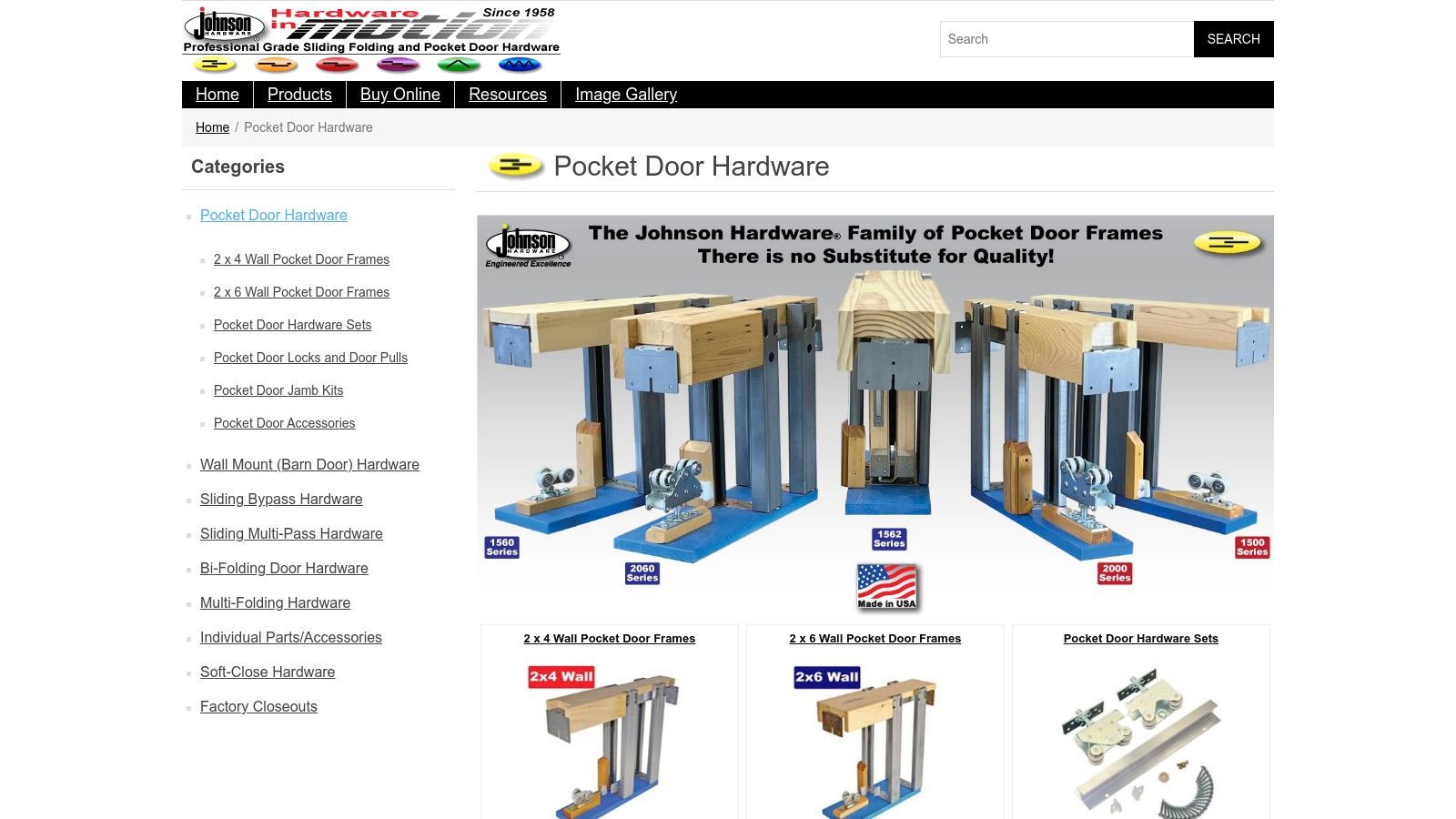
There are two primary types of sliding doors: bypass doors and pocket doors. Bypass doors slide along a visible track system, often with overlapping panels. Pocket doors, on the other hand, disappear into a cavity within the wall when opened, maximizing floor space and creating a seamless transition between rooms. This makes pocket doors particularly well-suited for small bathrooms, bedrooms, and closets where every square foot counts. For homeowners and contractors looking for different types of doors for homes, sliding/pocket doors present a space-saving solution. Learn more about Sliding/Pocket Doors to explore various options and styles.
Features:
- Space-saving design: The primary advantage of sliding/pocket doors is their efficient use of space.
- Wall pocket or surface-mounted track options: Choose between concealed pocket installations or visible track systems depending on your aesthetic preference and construction feasibility.
- Available in various materials and finishes: From sleek glass and metal to classic wood, sliding doors can be customized to complement any interior design.
- Single panel or bypass (overlapping) configurations: Single sliding panels are suitable for smaller openings, while bypass configurations with multiple panels are ideal for wider doorways or closets.
- Soft-close mechanisms in premium models: Higher-end models often feature soft-close mechanisms for smooth, quiet operation and to prevent slamming.
Pros:
- Maximizes usable floor space
- Creates wide openings when fully retracted
- Contemporary aesthetic option
- Ideal for tight spaces or small rooms
Cons:
- Pocket door installation is more complex and invasive, potentially increasing construction costs and time.
- Track systems can require periodic maintenance to ensure smooth operation. Dirt and debris can accumulate in the tracks, hindering movement.
- Less effective for sound insulation compared to solid-core hinged doors.
- May not provide as tight a seal as traditional doors, potentially allowing drafts or odors to pass through.
While pricing can vary significantly based on material, size, and hardware, pocket doors typically involve a higher initial investment due to the more complex installation process. Check with manufacturers like Johnson Hardware (https://www.johnsonhardware.com/pocket-door-hardware) for specific hardware requirements and pricing. When considering sliding/pocket doors, consider factors such as wall thickness, framing requirements, and the weight of the door panel. Consulting with a professional contractor is recommended, especially for pocket door installations, to ensure proper installation and functionality. This makes them a valuable consideration for builders, developers, and general contractors involved in new construction or remodeling projects for both residential and commercial properties. They appeal to homeowners, condo owners, and anyone undertaking renovations, particularly those between 25-65+ who are actively investing in their homes.
8 Home Door Types Comparison
| Product | Core Features / Characteristics | User Experience / Quality ★★★★☆ | Value Proposition 💰 | Target Audience 👥 | Unique Selling Points ✨ |
|---|---|---|---|---|---|
| 🏆 Gladiator Window and Doors | Custom, thermally rated, USA-approved; extra-large sliding, pivot, bi-fold, panoramic doors; fully loaded pergolas | Superior craftsmanship; industry-best warranty; 450+ happy customers | Lowest prices USA, Best Offer Guarantee, free shipping | Homeowners, contractors, developers | Massive custom doors up to 30 ft, electric louvers, motorized screens, unbeatable value |
| Solid Wood Doors | Natural hardwoods (oak, maple, mahogany); custom carvings | Timeless appeal; excellent durability when maintained | Higher cost, long-lasting if maintained | High-end residential, traditional aesthetics | Natural wood grain; refinishable multiple times |
| Fiberglass Doors | Fiberglass skin over foam core; wood grain texture; moisture resistant | Low maintenance; energy efficient; resists denting | Moderate to premium pricing | Energy-conscious homeowners, exterior use | Wood-like appearance; superior weather resistance |
| Steel Doors | Steel skin over foam core; fire resistant; magnetic weatherstripping | Strong security; moderate thermal insulation | Affordable compared to wood/fiberglass | Security-focused, commercial, residential | High security; fire resistance |
| Hollow Core Interior Doors | Lightweight wood frame with hollow core; standard sizes | Affordable; easy to install; basic privacy | Very budget-friendly | Interior residential (bedrooms, closets) | Light weight; wide style options |
| Solid Core Interior Doors | Wood composite core; sound dampening; fire-rated options | Better durability; good sound insulation | Mid-range price | Interior rooms needing noise reduction | Balance of durability and affordability |
| French Doors | Multiple glass panes; available in various materials | Elegant, natural light enhancing | Higher cost | Residential, connecting indoor/outdoor spaces | Architectural style; wide opening; customizable glass |
| Sliding/Pocket Doors | Space-saving; wall pocket or surface tracks; soft-close options | Smooth operation; modern aesthetics | Moderate to high depending on options | Small spaces, modern homes | Maximizes space; wide openings; contemporary style |
Choosing the Right Door
Navigating the world of different types of doors for homes can feel overwhelming, but by understanding the key differences between materials like solid wood, fiberglass, steel, and hollow-core or solid-core options, you can make an informed decision. From the classic elegance of French doors to the space-saving design of sliding/pocket doors, each type brings unique benefits to the table. Remember to consider factors like security, privacy, energy efficiency, and the overall style of your home when making your selection. When choosing the right door for your home, consider how much natural light it allows. If you're working with a dimly lit space, check out these tips on how to brighten a dark room and maximize natural light from How to Brighten a Dark Room: Easy Tips for a Brighter Space from Vivid Skylights.
For those seeking large-scale, custom solutions, consider exploring the premium features and competitive pricing offered by Gladiator Window and Doors. Their specialization in extra-large sliding, pivot, and bi-fold doors might be the perfect fit for your home improvement project, whether it's a new build, renovation, or remodel. The right door can significantly elevate your home's curb appeal, enhance energy efficiency, and boost its overall value.
Ready to transform your home with the perfect door? Explore the extensive range of high-quality doors at Gladiator Window and Doors. They offer a wide variety of different types of doors for homes, ensuring you find the ideal fit for your specific needs and aesthetic preferences.







